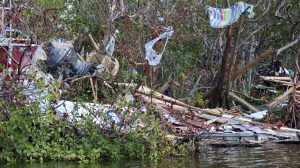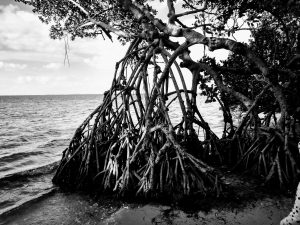Hurricane Ian made landfall on Sept. 28, and the vast storm surge from this event pushed extensive amounts of water into coastal areas. The mangroves that line our Florida coasts were in some cases completely submerged and the vast amounts of flotsam that floated into this ecosystem was left behind when the flood waters subsided. Mangroves are used to a harsh environment, but they have been impacted by Ian and could use some support with their long-term health.

When approaching the coast of Lee County along the thin road that bisects the mangrove forest to Pine Island, the wind sculpted, brown-burnt branches reach skyward to form a patterned dapple of skeletal vascularity and negative space of blue sky.
At the base a flush of green new leaf, the promise of potential, of survival against the tempest’s harrow of salt, wind and sea.
Speckled in among the now-visible reaches of mangrove forest are the remnants of flotsam and anthropogenic detritus, glistening rainbows of petrochemical sheen, the lives and patterns of existence cast aside by nature’s force.
As we in Lee try to pick up the pieces and arrange the form and function of our social, civilized order in negotiation with our natural world, we should restore this natural space with the utmost care. Now is the time to take what we can out of the mangroves, understanding that the plants are stressed and recovering.
Be aware that branches may appear dead — being shorn of leaves — but give them time to resprout and regenerate prior to removal or trimming. It is the opportune time to remove rubbish as we can both see it and negotiate a path to it.

As time goes on, the flush of green branches and tangle of roots will consume and enrapture these pieces of humanity to make it its own, or at best increase the difficulty of cleaning substantially.
Cleaning mangroves will help reduce the impact of any potential toxins or forever chemicals from garbage on the environment and wildlife.
Examine roots for inundation with soil, or presence of chemicals, where possible. Remove any obstruction to ensure that these vital structures can breathe.
Animals and fish can get tangled in lines, rope and can consume garbage out of necessity or mistaken identity — as is often the case with plastic waste — that may be detrimental to their wellbeing. The longer these items are left in the mangroves, the greater potential of negative impacts.
Removing them now will benefit the mangroves and the wildlife that make them home and aid in the recovery of this important ecosystem. These mangrove forests are the lungs, kidneys and liver of our coasts, they are sponges for the forces of nature and protect valuable upland areas from substantial erosion and wind damage.
Now is the time to pay respect and homage, to protect, promote, and support these vital ecosystems so they can be prepared for the next cyclone.
 0
0
